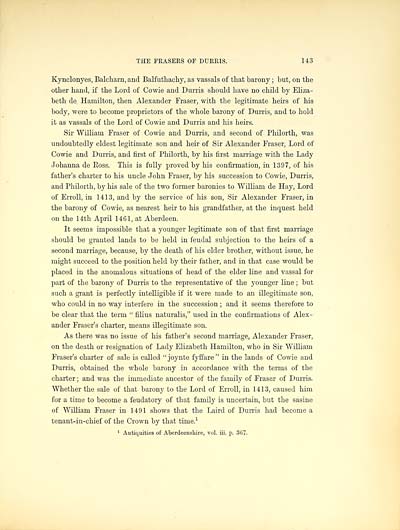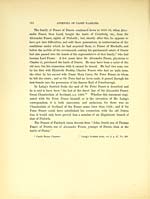Frasers of Philorth > Volume 2
(157)
Download files
Complete book:
Individual page:
Thumbnail gallery: Grid view | List view

THE FRASERS OF DURRIS. 143
Kynclonyes, Balcharn, and Balfuthachy, as vassals of that barony ; but, on the
other hand, if the Lord of Cowie and Durris should have no child by Eliza-
beth de. Hamilton, then Alexander Fraser, with the legitimate heirs of his
body, were to become proprietors of the whole barony of Durris, and to hold
it as vassals of the Lord of Cowie and Durris and his heirs.
Sir William Fraser of Cowie and Durris, and second of Philorth, was
undoubtedly eldest legitimate son and heir of Sir Alexander Fraser, Lord of
Cowie and Durris, and first of Philorth, by his first marriage with the Lady
Johanna de Pioss. This is fully proved by his confirmation, in 1397, of his
father's charter to his uncle John Fraser, by his succession to Cowie, Durris,
and Philorth, by his sale of the two former baronies to William de Hay, Lord
of Erroll, in 1413, and by the service of his son, Sir Alexander Fraser, in
the barony of Cowie, as nearest heir to his grandfather, at the inquest held
on the 14th April 1461, at Aberdeen.
It seems impossible that a younger legitimate son of that first marriage
should be granted lands to be held in feudal subjection to the heirs of a
second marriage, because, by the death of his elder brother, without issue, he
might succeed to the position held by their father, and in that case would be
placed in the anomalous situations of head of the elder line and vassal for
part of the barony of Durris to the representative of the younger line ; but
such a grant is perfectly intelligible if it were made to an illegitimate son,
who could in no way interfere in the succession ; and it seems therefore to
be clear that the term " filius naturalis," used in the confirmations of Alex-
ander Fraser's charter, means illegitimate son.
As there was no issue of his father's second marriage, Alexander Fraser,
on the death or resignation of Lady Elizabeth Hamilton, who in Sir William
Fraser's charter of sale is called "joynte fyffare" in the lands of Cowie and
Durris, obtained the whole barony in accordance with the terms of the
charter ; and was the immediate ancestor of the family of Fraser of Durris.
Whether the sale of that barony to the Lord of Erroll, in 1413, caused him
for a time to become a feudatory of that family is uncertain, but the sasine
of William Fraser in 1491 shows that the Laird of Durris had become a
tenant-in-chief of the Crown by that time. 1
1 Antiquities of Aberdeenshire, vol. iii. p. 367.
Kynclonyes, Balcharn, and Balfuthachy, as vassals of that barony ; but, on the
other hand, if the Lord of Cowie and Durris should have no child by Eliza-
beth de. Hamilton, then Alexander Fraser, with the legitimate heirs of his
body, were to become proprietors of the whole barony of Durris, and to hold
it as vassals of the Lord of Cowie and Durris and his heirs.
Sir William Fraser of Cowie and Durris, and second of Philorth, was
undoubtedly eldest legitimate son and heir of Sir Alexander Fraser, Lord of
Cowie and Durris, and first of Philorth, by his first marriage with the Lady
Johanna de Pioss. This is fully proved by his confirmation, in 1397, of his
father's charter to his uncle John Fraser, by his succession to Cowie, Durris,
and Philorth, by his sale of the two former baronies to William de Hay, Lord
of Erroll, in 1413, and by the service of his son, Sir Alexander Fraser, in
the barony of Cowie, as nearest heir to his grandfather, at the inquest held
on the 14th April 1461, at Aberdeen.
It seems impossible that a younger legitimate son of that first marriage
should be granted lands to be held in feudal subjection to the heirs of a
second marriage, because, by the death of his elder brother, without issue, he
might succeed to the position held by their father, and in that case would be
placed in the anomalous situations of head of the elder line and vassal for
part of the barony of Durris to the representative of the younger line ; but
such a grant is perfectly intelligible if it were made to an illegitimate son,
who could in no way interfere in the succession ; and it seems therefore to
be clear that the term " filius naturalis," used in the confirmations of Alex-
ander Fraser's charter, means illegitimate son.
As there was no issue of his father's second marriage, Alexander Fraser,
on the death or resignation of Lady Elizabeth Hamilton, who in Sir William
Fraser's charter of sale is called "joynte fyffare" in the lands of Cowie and
Durris, obtained the whole barony in accordance with the terms of the
charter ; and was the immediate ancestor of the family of Fraser of Durris.
Whether the sale of that barony to the Lord of Erroll, in 1413, caused him
for a time to become a feudatory of that family is uncertain, but the sasine
of William Fraser in 1491 shows that the Laird of Durris had become a
tenant-in-chief of the Crown by that time. 1
1 Antiquities of Aberdeenshire, vol. iii. p. 367.
Set display mode to:
![]() Universal Viewer |
Universal Viewer | ![]() Mirador |
Large image | Transcription
Mirador |
Large image | Transcription
Images and transcriptions on this page, including medium image downloads, may be used under the Creative Commons Attribution 4.0 International Licence unless otherwise stated. ![]()
| Histories of Scottish families > Frasers of Philorth > Volume 2 > (157) |
|---|
| Permanent URL | https://digital.nls.uk/96572140 |
|---|
| Attribution and copyright: |
|
|---|---|
| Description | A selection of almost 400 printed items relating to the history of Scottish families, mostly dating from the 19th and early 20th centuries. Includes memoirs, genealogies and clan histories, with a few produced by emigrant families. The earliest family history goes back to AD 916. |
|---|

